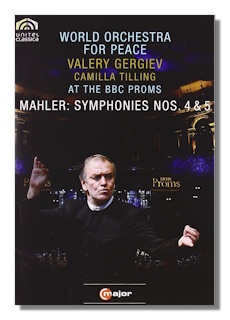
The Internet's Premier Classical Music Source
Related Links
- Mahler Reviews
- Latest Reviews
- More Reviews
-
By Composer
-
Collections
DVD & Blu-ray
Books
Concert Reviews
Articles/Interviews
Software
Audio
Search Amazon
Recommended Links
Site News
 DVD Review
DVD Review
Gustav Mahler

World Orchestra for Peace at the BBC Proms
- Symphony #4 in G Major *
- Symphony #5 in C Sharp minor
* Camilla Tilling, soprano
World Orchestra for Peace/Valery Gergiev
Recorded live at the BBC Proms - Royal Albert Hall, London, August, 2010
Unitel Classica/CMajor DVD 702608 LPCM Stereo DTS Widescreen Anamorphic
Gergiev has gotten mixed reviews for his Mahler in the past, but his recent efforts have garnered more consistent praise. Still, he'll probably be remembered more for his interpretations of Russian repertory and for his work in the opera house. These performances were presented to celebrate the 150th anniversary of Mahler's birth and the 15th anniversary of the founding of the World Orchestra for Peace.
Oddly, this orchestra, founded by Sir Georg Solti, has rarely convened over the years, averaging slightly more than one concert per year. Some have called the World Orchestra for Peace the finest in the world, as it is comprised of 110 members from over forty major orchestras, many of them principals in their respective ensembles. The first violins alone number at least fifteen concertmasters or leaders. But one might ask, does the sum of these impressive parts add up to an equally impressive whole?
The Mahler Fourth is paced moderately and given a rather Romantic, bucolic approach. This manner of interpretation works well with this the most peaceful, least angst-ridden of Mahler's symphonies. The first movement is cheerful and quite charming, well played by the orchestra. The ensuing panel is playful, featuring quite animated violin solos by Rainer Küchl, the concertmaster here. In the long third movement the strings play especially sweetly, and sweet also is the soprano soloist's voice in the finale. Camilla Tilling chimes right into the pastoral mood deftly delivering the heavenly scene envisioned by a child. Again, the orchestra plays with utter commitment and accuracy. There have been so many excellent Fourths over the years by Bernstein (on both Sony & DG), Szell, Solti and countless others. This one by Gergiev can stand with the better ones and is probably the one to get if you want video.
The Fifth, I think, is a somewhat stronger performance. It is also moderately paced and its first movement has plenty of weight and darkness: the funeral march IS funereal, and there is a sense of desperation right from the opening trumpet solo. The second movement comes across with plenty of stormy character and vehemence to fully match Mahler's marking, "Stürmisch bewegt; Mit groβter Vehemenz". The Scherzo is colorfully rendered here, capturing that Mahlerian mixture of joy and menace. The Adagietto is lovely and flows with a dark solemnity. Things brighten in the finale, of course, and here Gergiev imparts a chipper sense with bouncy string play and winds that can turn from heroic to playful on a dime. A fine Fifth, then, possibly a challenger to Chailly, Bernstein and others. It's hard to pick winners when there is so much competition, but I can say this performance is strong from start to finish and features excellent solo work by principal horn Gail Williams and principal trumpet Timur Martynov.
In fact, the playing by the entire orchestra throughout in both symphonies is splendid, which answers the question I posed at the outset: the sum of the impressive parts does indeed equal a marvelous whole! Excellent sound and imaginative camera work top off this fine effort.
Copyright © 2011, Robert Cummings





















